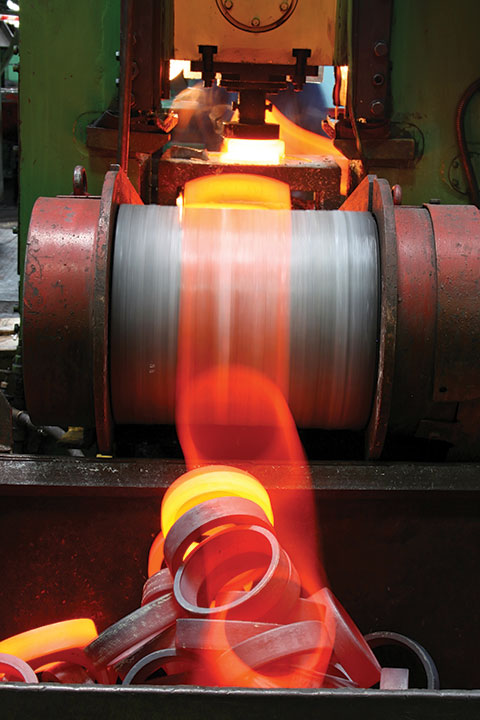
A common report is “I’ve got a hot bearing” …. But what is a “hot bearing”?

Photo credit: Getty Images / O_April
Very often the report of a hot bearing is based on someone putting their hand on the housing and it “feels” hot. So what temperature should a bearing be running at?
Predicting an Operating Temperature
What temperature does a bearing operate at?
This is a magical question and it is more about heat transfer than about bearings. Anyone who has studied any “heat transfer” equations will know the complexity and many variables and iterative equations that one has to use to determine the temperature of a mechanical part.
Knowing this, it is easy to understand that “what temperature should the bearing run at” is not a simple one. As there are too many variables to consider.
What is true is:
• When a bearing runs, it generates heat;
• The amount of heat generated is a function of bearing design, speed, oil viscosity, and load;
• Extra heat is generated by unusual loads, deterioration of lubricant, excessive wear, and contamination; and
• “Excess” grease is more about the bearing cavity not being able to purge and allow fresh grease to push out old grease.
What is more uncertain is the ambient temperature, any heat entering from the process (via conduction/convection/radiation), the housing design’s ability to transfer heat, and any layer of contamination on the housing that would limit the heat transfer.
Bearing manufacturers do have calculations to predict bearing operating temperatures; however, the confidence that the predicted operating temperature is accurate is moderate at best, as there is little ability to confirm the specific application conditions at the user level.
Some manufacturers provide a “reference speed,” which is the speed at which a bearing will achieve a steady-state temperature of 70 Celsius (160 Fahrenheit). What can we conclude? The bearing manufacturers feel that a normal operating temperature can be 70C. I think a lot of people will think that this is quite hot.
What are the temperature limits?
In terms of the bearing system only, one must consider the material limits of the bearing components and the lubrication temperature limit, both in the temperature limit of the grease or oil and the ability of the grease/oil to provide a lubricant film at the operating temperature.
The lowest temperature limit in a “bearing system” is whether there is a lip seal. Most commonly, a bearing’s integral lip seal is made of nitrile/Buna-N which is generally limited to 100C (212F). The housing itself may have a lip seal, which can be nitrile/Buna-N, with the same limit, or a Viton seal may be used, which has a temperature limit of about 200C (400F).
The cage material would be the next consideration, and the concern would only be if there is a polyamide cage, which has a steady-state temperature limitation of 120C (250F).
The most overlooked temperature limitation is lubrication. With lubrication, there can be three considerations:
1 – Does the lubricant have EP additives? If so, the temperature limit is 80C and above, which is when the EP additive may start to “plate out.”
2 – Is the lubricant grease? If so, the typical grease is lithium-based, which does not provide reliable performance over 120C (250F), and even “high temperature” greases may be limited to 150C (300F).
3 – In terms of the ability of the lubricant to provide a lubricant film, the maximum tolerable temperature should be based on ensuring that the Kappa (viscosity ratio) delivered by the oil is one or above. Once the temperature is high enough to drop the Kappa below one, then the bearing will suffer from metal-to-metal contact and start to wear, and this temperature may be lower than the bearing material temperature limits.
If the bearing is running at an elevated temperature and all the checks noted are within limits, you must also consider how a higher temperature can affect the lubricant.
Rules of Thumb
> For grease, for every 15C (27F) above 70C (160F), the relubrication frequency should double.
> For an oil bath, as the temperature increases, the more frequently the oil needs to be changed. For example, when the normal operating temperature is 50oC or below, the oil can be changed once a year, but at 100C, the oil will need to be changed every three months.
Absolute vs. Change in Temperature
Discussed so far is what are the “absolute” temperature limits in terms of the components of the bearing system. However, just because the bearing is operating at 80oC does not mean that everything is okay. If the bearing has been operating at 30C since start-up and recently the temperature has bumped up to 80C, then there certainly could be a problem.
Some electronic devices are being used to “alarm” when there is a temperature change. As an example, one device has a preprogrammed alarm of 105C (220F) – there in the alarm. The device can also be set such that it learns the normal operating temperature, then it will alarm when the temperature has elevated by 50C (90F).
Having a condition monitoring program that includes temperature monitoring is important and alarms can be set based on historical knowledge. The change in temperature can be arbitrary, such as two times change in standard deviation or four times change, which can be based on how critical the application is.
What should you do if there is a
change in temperature?
Instead of wondering what temperature the bearing can take, then when there is a change start investigating why. Is there a lack of lubrication? Have the operating conditions changed? Has the rotating assembly gone out of balance? The elevated temperature should initiate further investigation with more in-depth techniques such as vibration analysis. MRO
